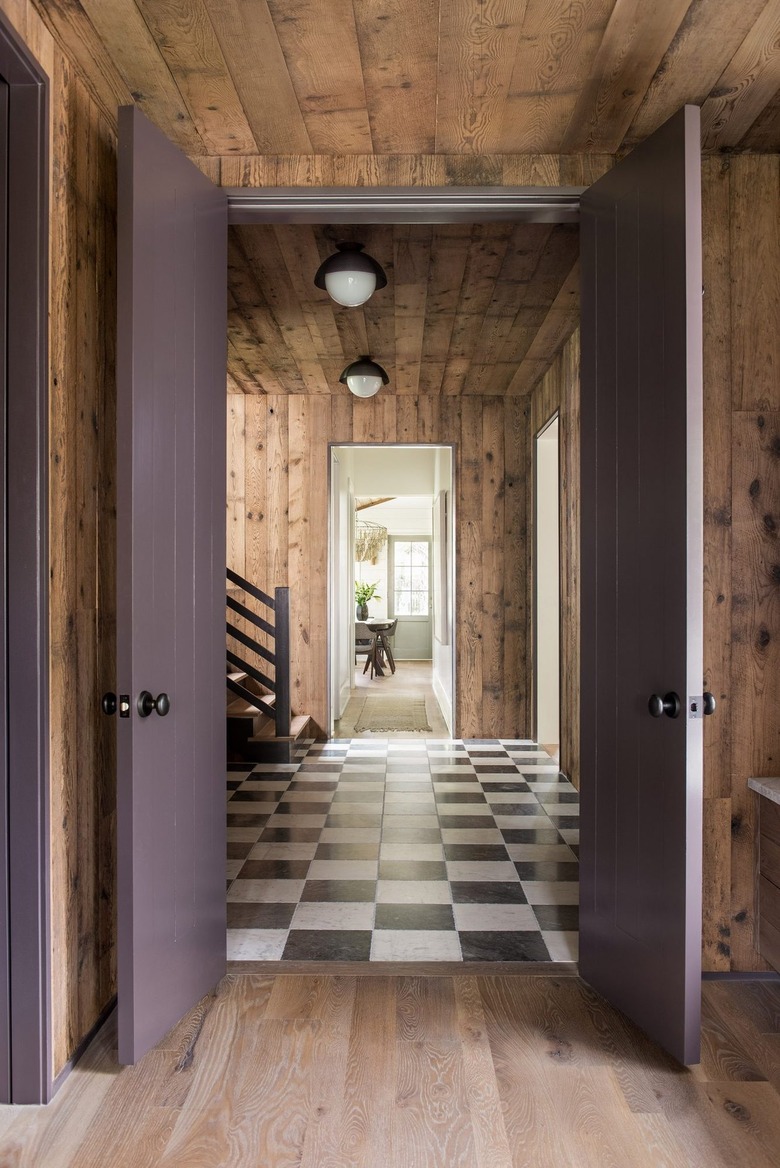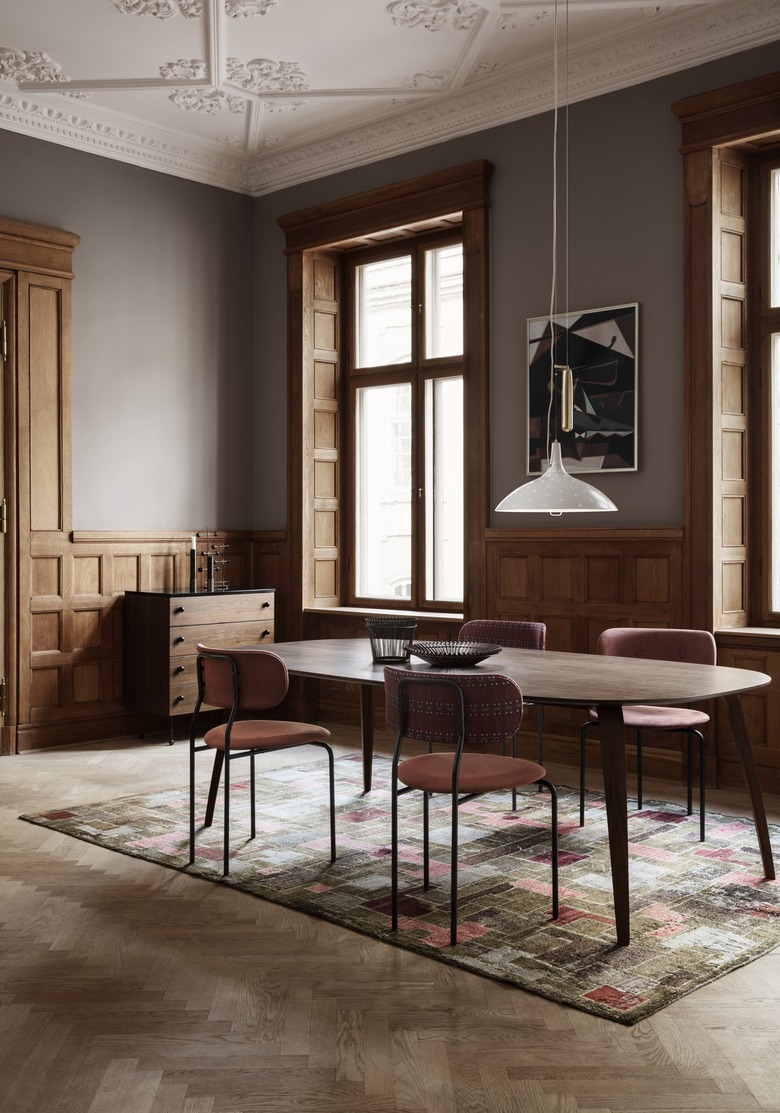14 Paint Colors That Go With Wood Paneling
Wood paneling is a wall treatment crafted from, well ... thin wood panels. It's prime for spaces that would benefit from an extra layer of coziness such as living rooms, libraries, and bedrooms, but can also add a stylish layer to spaces such as bathrooms, kitchens, and dining rooms. In the 1950s, wood paneling was a staple in American interior design, and then in the 1970s it peaked and quickly fell out of vogue. Initially, it was a functional element, adding insulation and budget-friendly character to functional rooms like basements and rec rooms, but it quickly evolved into a mainstay for homeowners. In days past, wood paneling had a decidedly retro vibe and was often reminiscent of cabins and cottages.
Today, wall paneling is back in a big way — thanks in part to the popularity of farmhouse-style decorating ideas which prominently showcase shiplap paneling. Wainscoting, beadboard, V-groove, and board and batten are also being used more and more. Oftentimes, wood wall panels are installed with the planks running horizontally or vertically. However, if you're looking for something a bit more eye-catching, you can create patterns such as chevron and herringbone as well. And while the material choices were limited back in the day, contemporary wall panels are now available in various materials including types of fiberboard like MDF, plywood, solid wood, reclaimed (salvaged) wood, and even corkboard.
"When selecting paint to accent natural wood paneling, choose colors with a cooler base tone to offset the warmth occurring in the wood. Soft blues or greens can pop really nicely against the wood without fighting the beauty of it," says Lisa Barton, founder of Soeur Interiors.
Applying a coat of paint to any wood wall paneling will mask the wood's natural features, but will still provide depth and interest. Lately, however, we've been admiring wood wall treatments in their natural, unaltered state, which also allows the grain and imperfections to play a starring role. That being said, the enviable warmth, dimension, and texture of wood wall panels can be accentuated, or minimized, with the help of the adjacent paint colors. The type of wood used and its finish or stain will determine the direction of your palette.
Intrigued? Scroll on for a few color ideas that will undoubtedly inspire your next home improvement project.
15 of the Best Colors to Pair With Wood Paneling
1. White
Wood paneling can impart a visual weight to spaces, so counter that by limiting it to a single wall and pairing it with crisp white paint. This living space looks fresh and inviting thanks to the absence of clutter, and a coat of bright white wall paint, but it remains cozy and warm thanks to the light wood paneling and caramel-colored velvet sofa. And bonus, the vertically oriented planks have the added benefit of adding height to the room — making it feel more airy and open.
2. Purple
Opt for wall panels that are made of plywood or light natural wood for a sleek, modern look that adds interest without visual distraction. This luxe corridor by Kingston Lafferty Design is a beautiful sum of its parts — featuring green marble floors, wood-paneled walls, and a rich purple shade painted on the ceiling. Pro tip: Often referred to as the fifth wall, ceilings afford another opportunity to inject color and texture into a room.
3. Sage Green
Embrace the beauty of the great outdoors by pairing the rustic, knotty wood in your home with a sage green wall color. We love the combination in this warm and inviting kitchen — it's giving us major mountain cabin vibes.
4. Hunter Green
Interior designer Raili Clasen also went with a shade of green, albeit much darker, for this kitchen setup. Paired with dark hunter green cabinets, the wood-paneled ceiling adds character and helps ground the space from above. The end result feels relaxed and welcoming despite the elevated decor (marble countertops, gold hardware, leather barstools).
5. Gray
Applying a plaster finish to walls in the form of Roman clay, limewash, or Tadelakt adds depth and subtle movement that reflects light beautifully. The team over at Jersey Ice Cream Co. went with a light gray plaster finish in an 18th-century farmhouse. When paired with dark brown board and batten paneling, the result is an intimate space with enviable old-world charm.
6. Lavender
Wood paneling is a beautiful complement to the color lavender, and also happens to bring out the purple hue's earthy side. Maximize visual interest with a heavily grained, salvaged wood and apply it to the walls, floors, and ceiling as Cortney Bishop did in this home. Black and white marble checkerboard flooring introduces a measured dose of contrast and pattern, resulting in an organic space that's full of texture and personality.
7. Cream
Double down on warmth by pairing neutral colors like cream or off-white with mid-tone wood paneling for a combo that's less jarring than bright white, yet still provides contrast. The accent wall in this dining room features dark wood paneling that matches the hardwood flooring, resulting in a seamless transition that also anchors the space. The adjacent cream walls offset the heavy finish.
8. Teal
A versatile hue that manages to straddle the line between approachable and refined is the color teal. When used in a room with plenty of exposed wood paneling and visible beams, the blue-green hue really shines and keeps the natural material from reading overly rustic. LuAnn McCants thoughtfully bookends the walls in this living room with a coat of teal paint, which adds visual weight to the soaring ceilings. The cool color balances the warmth of the wood and keeps the room feeling warm and inviting.
9. Taupe
Put a spin on a traditional cook space by pairing honey-colored wood paneling with taupe kitchen cabinets. Jean Stoffer executed this chic color idea flawlessly in a classic design that's chock-full of sophistication and rustic charm. Luxe features — such as milk glass pendant lights, marble countertops, and brass hardware — are elegant additions contrasted by rich hardwood floors.
10. Black
There's no question that black walls will add drama and depth to any room. However, when paired with walnut-stained wood paneling — as seen in this modern, Scandi-inspired dining room curated by Alison of Deuce Cities Hen House — the look is even more sophisticated and moody. An abundance of natural light, along with a white ceiling and matching curtains, keeps the dark color scheme bright and welcoming.
11. Brown
Brown paint enhances wood's inherently earthy vibe, and since they're part of the same color family, this pairing is a no-fail duo. Light cocoa-colored wall paint offers contrast to the chestnut paneling in this dining room by Gubi, accentuating the gorgeous box molding. However, keep in mind that there are so many shades of brown to choose from, making it easy to create more of a tonal look by selecting a hue that is similar to the wood paneling.
12. Greige
Wood wall panels are the perfect accompaniment to spatially challenged rooms — able to make a meaningful visual impact without eating up valuable real estate. For a really serene space, look no further than a combination of bleached wood wall panels and a light shade of greige. This minimal living room by Catherine Kwong used greige paint on the ceiling, adjacent wall, and connected hallway, which adds to the pared-down aesthetic without weighing it down.
13. Terra Cotta
For a measured dose of Southwestern allure, pair light wood wall paneling with a coat of terra cotta paint. This guestroom at Hotel Le Coucou Meribel fuses a desert-inspired palette made up of knotty pine walls and a terra cotta-hued ceiling. Bespoke lighting and furniture showcasing contemporary silhouettes complete the dreamy setup. The result is an elevated respite that's big on texture and bathed in earth tones.
14. Royal Blue
For a saturated hue that's bold enough to stand on its own, consider royal blue. Temper its vibrancy, as Commune Design did, by pairing it with ample amounts exposed wood for a free-spirited look that exudes sophistication and personality. A patterned coverlet and a handful of throw pillows are all you need to complete the scheme.
Colors That Go With Wood Paneling
Colors That Go With Wood Paneling
Wood wall paneling is available in a range of colors from rich walnut to pale plywood. It adds texture, character, and warmth to rooms in ways that can't be achieved with paint on its own. The wood grain, wood tone, and application are important factors in determining the right color to pair with your paneling, but we're partial to the following hues:
- White
- Purple
- Sage green
- Hunter green
- Gray
- Lavender
- Cream
- Mauve
- Teal
- Taupe
- Black
- Brown
- Greige
- Terra cotta
- Royal blue















